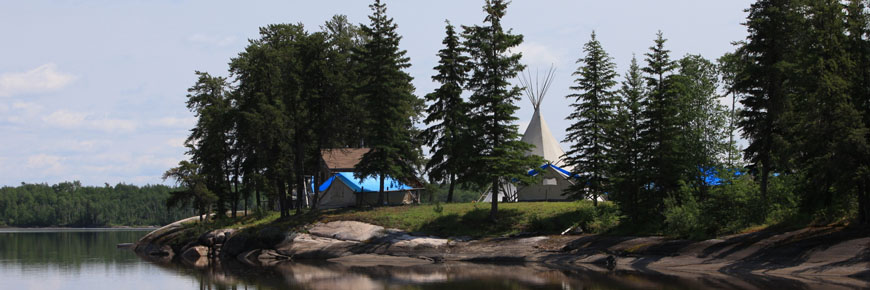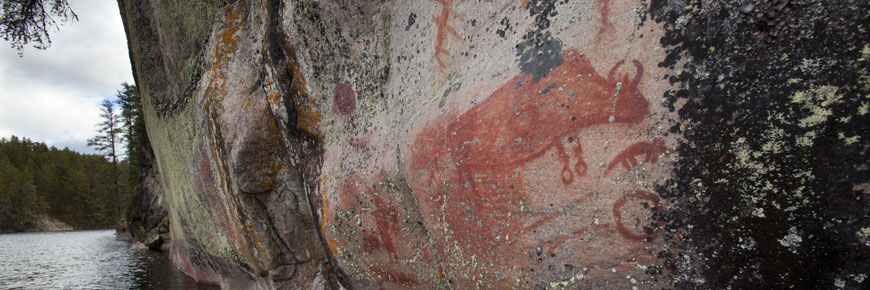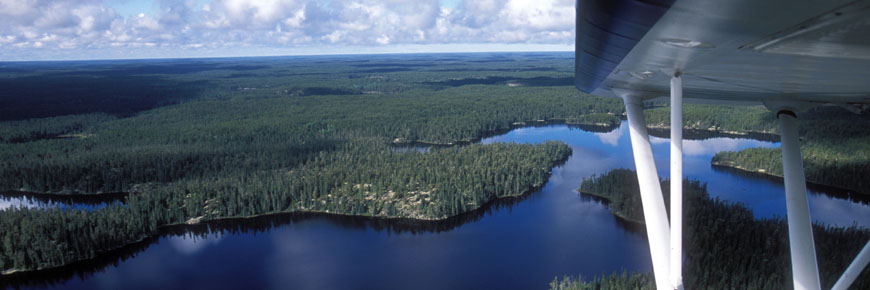
A community cultural camp on Weaver Lake in Pimachiowin Aki (Photo: © Pimachiowin Aki Corporation)
The life-giving forest
Pimachiowin Aki is Canada’s first “mixed” UNESCO World Heritage site, recognized for both its cultural and natural value.
Caring for a great forest is the work of many generations—past, present and future.
The caretakers of Pimachiowin Aki, Canada’s newest UNESCO World Heritage site, are the Anishinaabeg, or Ojibwe people. For millennia they have followed the ancient tradition of Ji-ganawendamang Gidakiiminaan (Keeping the Land). Their expertise today comes from knowledge and practices handed down over 6,000 years.
Covering 29,040 square kilometres, Pimachiowin Aki, (Pim-Match-cho-win-Ahh-Key) is a huge tract of boreal forest straddling the Manitoba and Ontario borders.
It is a land of greens—black spruce, jack pine, balsam fir, poplar and carpets of feathermoss. Blues flow through the greens in the form of undammed rivers and pristine lakes. The vast stretches of forest and wetland are home to many iconic boreal species, including one of the largest herds of woodland caribou south of Hudson Bay.
In the language of the Anishinaabeg, Pimachiowin Aki means “the land that gives life.” Inscription on the World Heritage List means that the land’s First Nations stewards can now share this life with the world.The long and winding road to UNESCO
This is Canada’s first “mixed” World Heritage site, recognized internationally for both its cultural and natural value. It reflects the world view of the Anishinaabe caretakers, for whom nature and culture are parts of a living whole, as interdependent as the sapwood and heartwood of a tree.
There are 38 such mixed UNESCO sites in the world. They range from Chiribiquete National Park in Columbia, a stunning area of tabletop mountains and 20,000-year old wall paintings, to the Ahwar of Southern Iraq, an ancient landscape of wetlands and relict Mesopotamian cities.
The long quest to safeguard Pimachiowin Aki began in 2002, when First Nations of the area met to work out a plan for proposing a parcel of their traditional territories as a World Heritage site. The governments of Manitoba and Ontario, also recognizing Pimachiowin Aki as a superb example of intact boreal forest, joined the process.

As the lead agency for World Heritage Sites in Canada, Parks Canada got involved early on. “We went to Parks Canada first for guidance and advice,” says Gord Jones, Project Manager for the non-profit Pimachiowin Aki Corporation. “They were with us through the whole process.”
All Canadian World Heritage nominations must be developed in close cooperation with Parks Canada, who represents the Government of Canada. The process to develop a nomination can take many years.
Nominations of Pimachiowin Aki were submitted to the World Heritage Committee twice, in 2012 and 2015, before being inscribed on the List in July 2018.
Pimachiowin Aki comprises the traditional lands of four First Nation communities—Bloodvein River, Little Grand Rapids, Pauingassi and Poplar River—along with Atikaki Provincial Park in Manitoba and Woodland Caribou Provincial Park and Eagle-Snowshoe Conservation Reserve in Ontario.
“We’ve always been talking about trying to preserve our land, to keep it as natural as it was... We’re trying to say to the world: ‘We don’t want to rush with change. We want to stay within the present moment the best we can.’ And that means trying to create this natural environment [for] the longest we can, and to hold onto it, in its purest form, for the next generation.”
As Gord Jones says, Pimachiowin Aki is a major boost for such global campaigns as fighting climate change and stemming biodiversity loss. It also marks a significant step towards Canada’s biodiversity goal of preserving 17 per cent of its lands by 2020.

For the Pimachiowin Aki Corporation, which has representation from the four First Nations and two provincial governments, inscription as a World Heritage site opens an exciting way forward. In partnership with First Nations communities, the corporation will continue its initiatives in the areas of language, art, archaeology, sustainable tourism and ecological research.
And todays’ forest caretakers have a world-recognized place to stand as they reach out to the caretakers of tomorrow.
- Date modified :